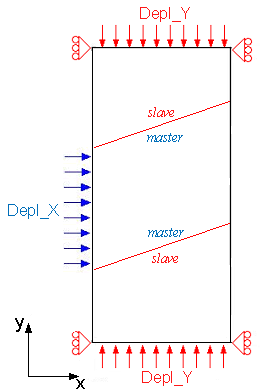1. Reference problem#
1.1. Geometry#
The structure is a healthy rectangle in which two oblique interfaces are introduced. The interfaces are parallel and placed as shown on the []. The dimensions of the structure as well as those concerning the geometry of the interfaces are:
\(H=9m\);
\(L=4m\);
\(B=4m\);
\(h=2.125m\);
\(\alpha =13.49\)

Figure 1.1-1: Geometry of the structure and positioning of interfaces s.
1.2. Material properties#
Young’s module: \(E=100\mathrm{MPa}\)
Poisson’s ratio: \(\nu =0.3\)
1.3. Boundary conditions and loads#
The blocking of horizontal movements is imposed at the four corners of the structure (see [Figure 1.3-1]). On the lower and upper edges of the rectangle, movements along the \(Y\) axis are imposed which will close the interfaces in order to generate contact pressure. The middle block is subject to significant sliding by applying a controlled movement along the \(X\) axis on its left edge.
The numerical values of the imposed movements are:
\({\mathrm{Depl}}_{X}=2.00m\);
\({\mathrm{Depl}}_{Y}=1.0E-2m\).
Their application is carried out according to a conventional ramp function, in 4 load steps.
The Coulomb coefficient of friction is taken to be equal to \(\mathrm{0,5}\).

Figure 1.3-1: Illustration of boundary conditions and loads.